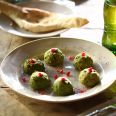Vodka
The story of Russian cuisine would be incomplete without a mention of vodka considered the main national beverage of the Russians

Moscow Vodka
1.5L wine spirit
50g ginger
50g sage
50g peppermint
50g tormentil
1.5 cups water
Put ginger, sage, peppermint and tormentil in a big bottle and fill it with spirit. Infuse in a warm place for 5-6 days. Shake up every day. Then strain through several layers of gauze.
Caraway Vodka
2L vodka
1/2 cup caraway seeds
1 cup water
100g sugar
Put caraway seeds in a big bottle and add vodka. Leave in a warm place for 2 weeks. Then strain the vodka, stir in chilled sugar syrup and strain again through filtering paper. If the vodka is not clear enough, strain it again.
Double Caraway Vodka
3.5L vodka
500g caraway seeds
50g anise
20g dill seeds
20g violet root (sliced)
30g wild orange peel (dry)
Pound everything and add 3.5 litres of 40-45% vodka. Cork the bottle and infuse in a warm place for 2 weeks. Then strain it and pour into bottles.
Grain Vodka With Yeast
There are two ways to make grain vodka with yeast. First: let a half-bucket rye, wheat or barley sprout. Pound them. Soak 10-12 loaves of black bread in 15 litres water. Stir. Add 750g yeast.
If there is not enough bread (8 loaves), boil a pan of potatoes. Mash them, combine with grain and bread.
Brewing in a warm place lasts a week. Then distil it through a steam device.
Grain Vodka With Yeast (Variant 2)
There is another way to make grain vodka with yeast.
Let the wheat sprout, process through a meat or a coffee grinder (you can also pound it). Add water, yeast and put in a warm place. Take 10kg of wheat per 30L of water and 0.5kg of yeast. When the brewing is finished, distil it through a steam device.
Grain Vodka On Hop
To make grain vodka on hop, let wheat or rye sprout in a wooden trough, stirring periodically. Then boil potatoes, pound them. Brew hop. Prepare so-called zator - add boiled hop (3L) to the wash that remained from the previous time (1.5-2 L). Then mix everything together - wheat or rye, potatoes and zator. Grind grains.
Leave in a warm place until it stops brewing and making noise. Then distil it through a steam device.
1 bucket of grain per 2 buckets of boiled potatoes. The result is 2L of grain vodka.
Grain Vodka With Potatoes
To make grain vodka with potatoes, make malt as is described in the first recipe (let grains sprout, dry and grind them). Boil potatoes. Pound with the water remaining from the cooking. Add the malt flour. Pound until homogeneous and viscous. Everything should be very hot. Sprinkle the remaining flour and leave overnight. 10-12 hours later, pour it in a barrel, add 0.5kg yeast. The brewing should last 5-6 days. Use 2 buckets of malt per 4-5 buckets of potato. Distil it through a steam device.
Quince Vodka
To make quince vodka, take overripe quinces, pound or grate them. Chop very finely a bunch of rye straw. Squeeze out juice from the resulting mixture. Use 8 cups of this juice per as much vodka. Add sugar and 50g vanilla sugar. Pour in a big bottle, leave for a week. Strain.
Anise Vodka
There are over 20 ways to make anise vodka. Here is one of them.
Pound 800g anise, add 6 litres of beer and distil until the liquid smells of anise. Add 12 litres of vodka to the distilled liquid, add 100 more grams of pounded anise, distil, sweeten optionally, strain.
Alkermesnaya Vodka
An ancient recipe for Alkermesnaya vodka. Take 32g cinnamons, 90g lemon peel, 90g cardamom, 8g rosemary, crush all, add 1.8L double vodka, infuse and strain. Make a syrup from 800g sugar and 1.2L water, carefully skimming, and combine with the infused vodka. Pour in bottles and put a leaf of gold leaves in each bottle (3 leaves per 1.2L vodka), stir.
Aromatic Vodka
The recipe is widely known. Take 85g sage, 65g hyssop, 50g marjoram, 50g olive beans, 35g cornflowers, 35g caraway seeds, 25g lavender flowers, 25g hairgrass root, 25g peony root, 16g angelica, 12g peretrun.
Crush and pound the spices, add a bucket of simple vodka, infuse a few days, strain.
Yeast Vodka
Both beer yeast, and grape yeast remaining on the bottom of the barrels are good to make yeast vodka.
Fill the still with yeast to two thirds. The fire under the still should be adjusted easily. Stirring the yeast continuously, so that it does not burn, heat it until the yeast start rising, then reduce the fire to minimum, cover with a cap, insert pipes, seal the seams, the cooler and the receiver, and distil vodka at low heat, for example on coals. For second distillation the still needs to be cleared carefully.
To improve the taste at the second distillation, you can add some aromatic substances - cloves, ginger, hairgrass, cinnamons all finely chopped. Add a little salt or fried tartar. Distil at low heat, not letting the spirit get into the deposit.
The same procedure is followed to distil vodka from spoiled grape wine.
Grape Seeds Vodka
To prepare this grade of vodka, fill the still with grape grains full. Take 30L grains per 1L water, or better wine yeast, or 1/3L wine yeast and 2/3L water. Cover with a cap at least 35 cm in diameter and four pipes. Seal the seams. You can use two receivers and two coolers to make the process quicker. Do not use a utensil covered with cloth as in this case the best spirit gets lost. First, attach a big receiver to the end of a refrigerating pipe which receives the spirit from steam and when it starts dropping, Attach another one. The first portion of whitish colour needs to be collected separately. Thus more high-quality spirit is collected.
Pkhali from the Chef of Kharcho Restaurant
Pkhali is one of the most popular and beloved by many people dishes of the Georgian cuisine. It is very easy to cook and there are so many variations. You may use almost any vegetables and herbs to co...
Marinated cod
There are lots of recipes to cook marinated fish. A great variety of such recipes consists of frying pieces of fish in oil. I would like to offer you a recipe of lean fish in marinade. It gets tasty, ...
Fresh sea bass carpaccio with citrus sauce
Hospitable and vivacious brand-chef of Park Giuseppe Restaurant Sergey Lasarev showed us how to cook fresh sea bass carpaccio with citrus sauce – a simple but dainty food.







